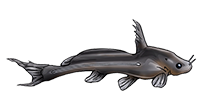Boyle, KS, O Colleye & E Parmentier, 2014. Sound production to electric discharge: sonic muscle evolution in progress in Synodontis spp. catfishes (Mochokidae). Proceedings of the Royal Society B: Biological Sciences 281: 20141197.
Abstract
Elucidating the origins of complex biological structures has been one of the major challenges of evolutionary studies. Within vertebrates, the capacity to produce regular coordinated electric organ discharges (EODs) has evolved independently in different fish lineages. Intermediate stages, however, are not known. We show that, within a single catfish genus, some species are able to produce sounds, electric discharges or both signals (though not simultaneously). We highlight that both acoustic and electric communication result from actions of the same muscle. In parallel to their abilities, the studied species show different degrees of myofibril development in the sonic and electric muscle. The lowest myofibril density was observed in Synodontis nigriventris, which produced EODs but no swim bladder sounds, whereas the greatest myofibril density was observed in Synodontis grandiops, the species that produced the longest sound trains but did not emit EODs. Additionally, S. grandiops exhibited the lowest auditory thresholds. Swim bladder sounds were similar among species, while EODs were distinctive at the species level. We hypothesize that communication with conspecifics favoured the development of species-specific EOD signals and suggest an evolutionary explanation for the transition from a fast sonic muscle to electrocytes.
Sonic muscle evolution in Synodontis
- Silurus
- Posts: 12420
- Joined: 31 Dec 2002, 11:35
- I've donated: $12.00!
- My articles: 55
- My images: 893
- My catfish: 1
- My cats species list: 90 (i:1, k:0)
- Spotted: 424
- Location 1: Singapore
- Location 2: Moderator Emeritus





